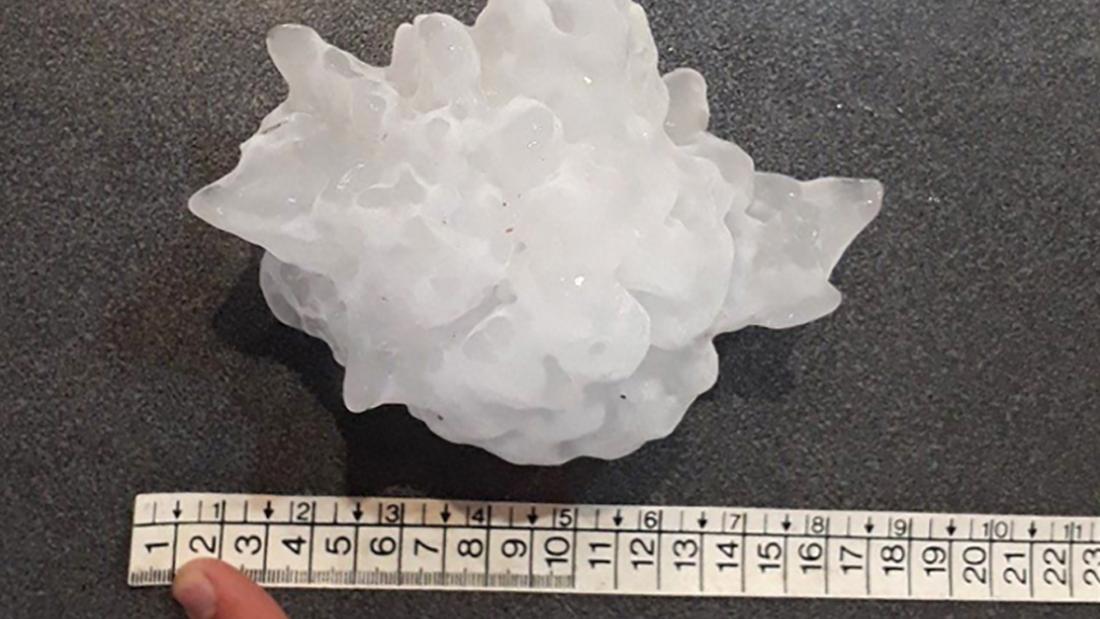[ad_1]
“In the last two decades, there’s been about 10 reports of hail about 6 inches in maximum dimension or greater in the US,” Pennsylvania State University associate professor of meteorology Matthew R. Kumjian told CNN. “Those are exceptionally rare.”
One of the hailstones from the 2018 storm that pelted the town of Villa Carlos Paz, Argentina, may have measured from 7.4 to 9.3 inches across, based on calculations from photographs. It may have set a world record, he said.
How on Earth does hail get so big?
A lot of it comes down to how long the hail is caught in an updraft.
“The upward winds are necessary for suspending the hail in the storm,” Ward said. “The stronger the updraft, the larger the hail can be. A weaker updraft will not suspend the hail in the storm long enough for it to grow.”
“They’re pretty common in the US Great Plains in the springtime and they are responsible for the most violent tornadoes, the largest hail and very heavy rains,” he said.
The environment the day of the storm in Argentina made it likely for a supercell storm, but nothing on the radar indicated the hail would be that large, Kumjian said.
No one died in the storm that day and there were no reports of injuries in the local media, he said.
“[Hail] can punch through roofs, windshields, and be lethal if it directly impacts a human or animal,” Kumjian said.
A resident of the town reported hail made a “tremendous dent” in a neighbor’s car and cracked a nearby window ledge, according to the study.
A teenager preserved a massive hailstone
The researchers interviewed teenager Victoria Druetta, who darted outside wearing her brother’s motorcycle helmet to retrieve one of the massive hailstones on February 8, 2018.
“It was really impressive, we were all in shock,” Druetta said, according to the study. She said she saw a piece of it break off before it “smashed” into the ground.
Druetta preserved the mega hailstone in her freezer. When she took it out to measure several hours later, it was 7 inches in maximum dimension, the study said, and probably not even the biggest hailstone to fall that day.
“That’s actually the Southern Hemisphere record, as far as we can tell, for maximum hail size,” Kumjian said. Researchers called it “Victoria’s hailstone” in the study.
The hailstorm was well-documented on social media, with many posting videos of the hail pelting the town. Druetta shared her Snapchat videos with the researchers.
When these storms happen in sparsely populated places in the US, there’s no one there to document them. This case was a break for researchers.
“There were plenty of people who were there to witness it,” Kumjian said. “Given that this was an extreme event, we wanted to understand why so you can better anticipate these extreme events in the future.”
Analyzing social media videos helped researchers
As the hailstones were not measured, researchers did an analysis of videos posted of the storm on social media, Kumjian said. They measured the pixels of each hailstone on the screen.
When they visited the town during a research trip a year later, they interviewed witnesses and went to the places where the damage occurred. They measured light poles, awnings and other objects so they could relate the pixel sizes to these physical objects, he explained.
They took measurements from photographs of a video from social media and estimated one of the hailstones to be between 7.4 and 9.3 inches — a possible world record, the study said.
The team hopes that their findings bring more awareness to these massive types of hail for safety reasons.
“It’s important to realize that these extreme types of hail events don’t just happen in Kansas,” Kumjian said. “They can happen in multiple places around the world.”
He hopes that people will report these large hailstones so he and others can study them.
“We don’t know about these cases unless people report them,” he said. “By drawing attention to this type of extreme event and the fact that hail really can get 8 to 9 inches in maximum dimension … hopefully improves reporting down the road.”
CNN’s Taylor Ward contributed to this report.
[ad_2]
Source link


